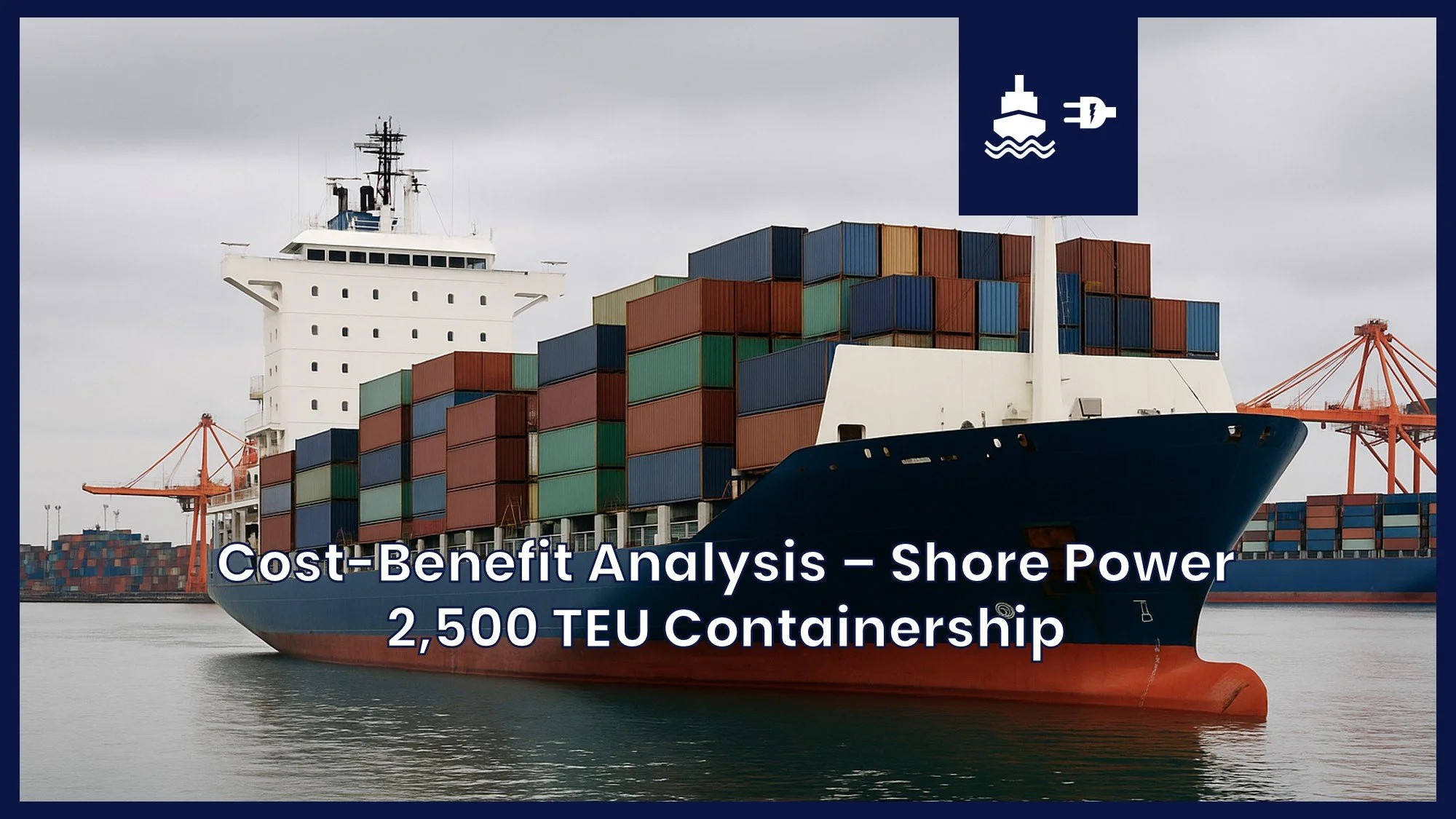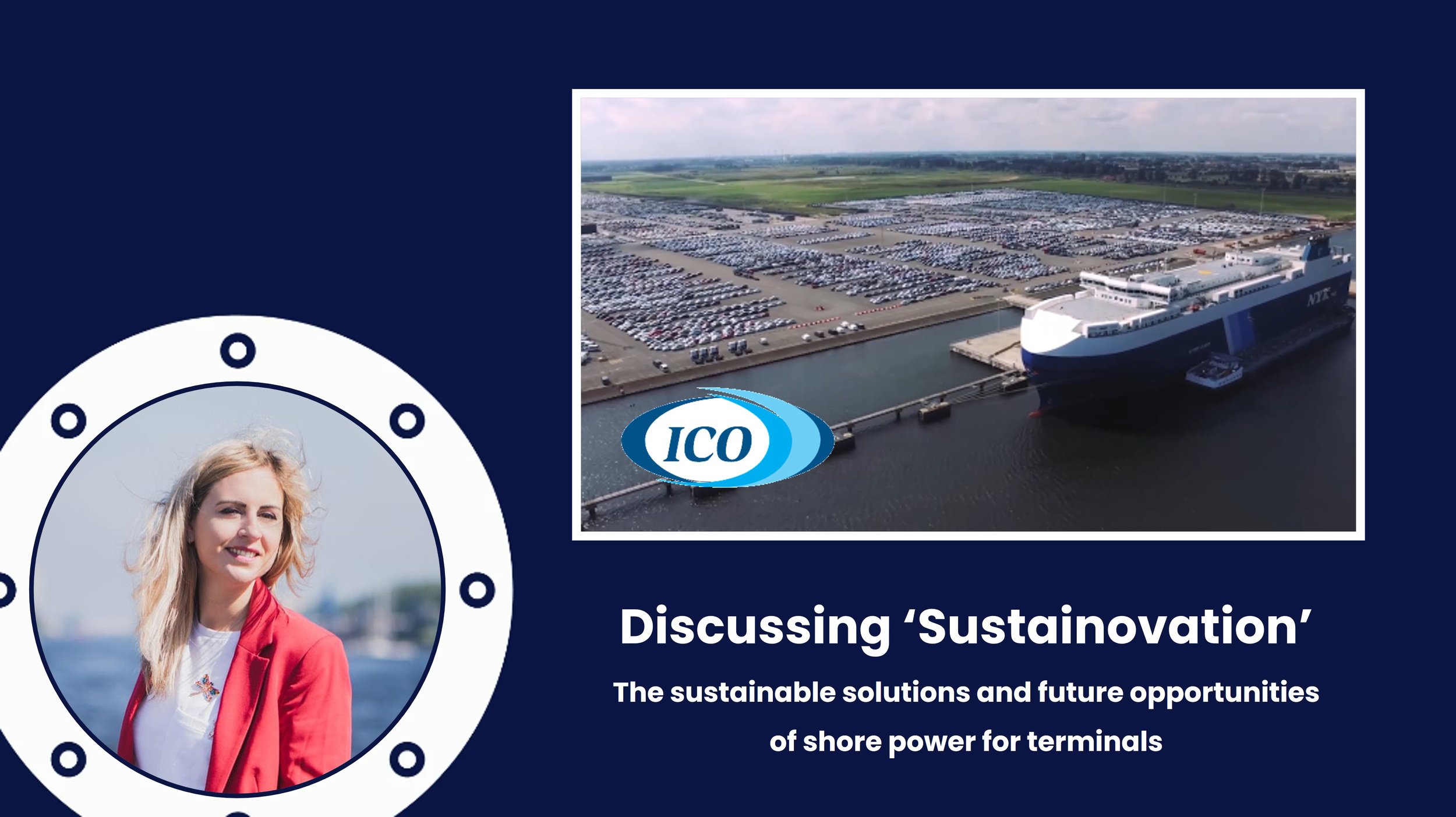Shore power electricity demand in EU ports from 2030 onwards
Average shore power demand across EU ports is estimated at 6 to 13 TWh per year from 2030 onwards
Accurate estimates of power demand at EU ports have become increasingly critical due to stringent regulations, such as AFIR and FuelEU Maritime. AFIR mandates that by 2030, 90% of all port calls by container and passenger ships at TEN-T ports must use shore-side electricity. However, accurately determining this power demand is complex due to variations in ship sizes, onboard equipment, operational profiles, and design specifications. This uncertainty places considerable pressure on terminal owners, port authorities, and developers to plan shore power infrastructure without fully reliable data.
This blog evaluates three methods to estimate the Total Addressable Market (TAM) for shore power in EU ports: a top-down approach using fuel consumption data from the EU MRV (Thetis) database, a bottom-up approach based on Sustainable Ships’ vessel-level power demand dataset, and an analysis conducted by the International Council on Clean Transportation (ICCT). The top-down method, anchored in MRV data, estimates annual demand at approximately 11.8 TWh. ICCT’s estimate is lower at roughly 5.9 TWh, derived using data from the World Ports Index and MRV. Meanwhile, the bottom-up method, based on the Sustainable Ships dataset, yields a slightly higher preliminary estimate of around 13.1 TWh, validating the MRV results while highlighting discrepancies for certain ship types.
Together, these findings suggest that meeting EU shore power targets will require infrastructure capable of delivering between roughly 6 and 13 TWh annually. This clearly indicates the significant investment, planning, and coordination required. Explore the detailed methodologies and assumptions in the sections below, and sign up to access comprehensive tools, databases, and expert support.
Members only
(1) Top-Down estimation of shore power electricity demand
Total amount of fuel consumed at berth converted into kWh results in ~12 TWh demand
This method estimates the Total Addressable Market (TAM) for shore power in terawatt-hours (TWh) by converting the total amount of fuel consumed at berth into its energy equivalent and adjusting for engine efficiency. This top-down approach offers a high-level, yet robust approximation of the electricity required to fully electrify ship operations at berth across the EU, clearly showing the scale in terms of infrastructure planning and grid readiness. It avoids assumptions about ship types, call durations or operational schedules, making it particularly suited for energy system-level forecasting and strategic investment planning for ports and utilities.
As a starting point, reported fuel consumption data from the EU MRV (Thetis) database is used. According to the most recent dataset from 2023, ships at berth consumed approximately 2.57 million tonnes of marine fuel annually across EU ports. This figure includes fuel burned while docked and covers all vessel types over 400 GT reporting under the MRV framework. Note that this excludes ships that are note required to report their fuel consumption under the MRV framework. Because MRV does not show different fuel types used but a total fuel consumption only, a conservative midpoint estimate for the lower calorific value (LCV) of 41.5 MJ per kg is used to determine energy consumption. This leads to an energy total of just over 106.5 petajoules per year, which translates into approximately 29.6 terawatt-hours (TWh) of raw thermal energy.
Not all of the primary energy is converted into useful onboard power. Marine auxiliary engines, which typically supply electricity while ships are in port, operate at an efficiency of around 40 percent. When this efficiency factor is applied, the actual useful electrical energy consumed at berth is 11.84 TWh per year. This is the figure that represents the potential electricity demand that would need to be met through shore power to fully displace onboard generation.
If needed, this number can be further aligned with policy targets, in particular the Alternative Fuels Infrastructure Regulation (AFIR), which mandates that 90% of all port calls at TEN-T ports need to be electrified by 2030. Adjusting the total demand accordingly yields a policy-relevant TAM of approximately 10.6 TWh per year, which is the amount of shore power the EU would is required to supply to meet its obligations under AFIR, assuming full compliance and electrification of the relevant fleet segments.
-
The baseline for this method is the EU MRV (Monitoring, Reporting and Verification) database, specifically the Thetis MRV 2023 dataset. This dataset reports that the total fuel consumed at berth in EU ports during 2023 was approximately 2,568,156 metric tonnes. This figure aggregates all fuel used while ships are docked, and includes consumption by specific ships over 400 GT, as reported under MRV obligations. The fuel types are not separated in the dataset, but likely consist primarily of Marine Diesel Oil (MDO), Marine Gas Oil (MGO), and Heavy Fuel Oil (HFO).
-
Each marine fuel type has a different energy content. According to Annex I of the FuelEU Maritime regulation, the standard Lower Calorific Value (LCV) is 42.7 MJ per kg for MDO and MGO, and 40.4 MJ per kg for HFO. Because the fuel type breakdown in the MRV data is not specified, this method uses a midpoint estimate of 41.5 MJ/kg to represent an average LCV across all fuels consumed at berth. In case more MGO is used for power at berth, the estimate may be slightly conservative. Additionally this method does not account for fuels such as LNG and methanol, though these are likely to be minor in the 2023 berth consumption.
-
The total chemical energy content is calculated by multiplying the total fuel mass by the LCV. This yields a thermal energy figure of ~106.6 petajoules per year, or ~29.6 TWh. This figure reflects the primary energy content of the fuels and does not yet consider how efficiently this energy is used onboard or the actual electricity required.
-
Marine auxiliary engines typically operate at an average efficiency of 40%, meaning that only 40% of the fuel’s chemical energy is converted into usable electrical power, with the remaining 60% lost as heat. Applying this efficiency factor to the previous energy value results in a useful electrical demand of ~11.84 TWh per year. This represents the amount of electricity or Total Addressable Market (TAM) that would be required from shore power to fully displace auxiliary engine use at berth.
However, as highlighted by the ICCT report, boilers contribute a significant portion of onboard energy use at berth. According to the report, boilers account for approximately 32% of total energy consumption, used primarily for heating and steam. Since boilers are not typically replaced by shore power, this analysis conservatively excludes boiler energy demand from the electrification estimate. If future shore power systems or onboard systems also electrify boiler loads, total electricity demand could increase substantially.
-
The final step is to align the technical potential with the regulatory scope of AFIR, which requires that by 2030, at least 90% of port calls by container and passenger ships at TEN-T ports are supplied with shore-side electricity. Applying this 90% factor to the 11.8 TWh value yields a policy-adjusted Total Addressable Market (TAM) of 10.65 TWh/year.
This figure reflects the realistic policy-driven electricity demand that EU ports would need to supply annually, assuming full compliance and full auxiliary electrification for all relevant vessel calls. It is not a technical maximum, but a compliance-aligned operational target.
(2) Bottom-up estimation of shore power electricity demand
Average shore power demand multiplied with port calls and stay to yield ~13 TWh demand
The bottom-up estimate is based on average power demand and estimates of berth durations. While these berth durations are not derived from measured AIS or MRV call data, it illustrates how bottom-up figures compare to reported consumption.
The EU MRV 2023 data provides the amount and type of all ships in the EU under MRV regulation. This information is combined with the Sustainable Ships Average Shore Power Demand Database (link) in order to compare and validate the database with the EU MRV numbers. The results, provided in Table 2, show that the total energy demand for the bottom-up approach is 13.12 TWh. The difference between the top-down approach from EU MRV and the bottom-up approach when using the Sustainable Ships’ database differs by about 10%. The biggest differences in ship types are with bulk carriers and RoRo ships. Energy demand of bulk carriers as per MRV is 64% less than estimates by Sustainable Ships, whilst energy demand of RoRo ships estimated by MRV is 72% higher.
-
The Sustainable Ships’ Average Shore Power Demand Tool (link) provides detailed estimates of shore power demand for all ship types, compiled from reputable sources such as IMO, DNV, and EMSA, backed by the Sustainable Ships’ Database. For this document, only IMO and DNV estimates are considered, since EMSA's reported power demands appear approximately three times higher and therefore potentially overstated. Average power demand values from IMO and DNV are combined and multiplied by the total number of vessels, estimated port calls per year, and duration of port stays in hours, resulting in the total annual energy demand per ship type.
Data on average berth durations are sourced from the United Nations Conference on Trade and Development (UNCTAD). According to UNCTAD's Review of Maritime Transport (2019), ships globally spent a median of 23.5 hours in port in 2018. Where more specific berth-time data by ship type is unavailable, this standard duration of 23.5 hours is applied.
Unfortunately, detailed data on annual port call frequency per ship type in the EU is lacking. To address this gap, a general assumption of 100 port calls per ship per year is applied uniformly across ship categories. This allows for a meaningful scale comparison between the bottom-up approach using Sustainable Ships’ database and the top-down estimates derived from EU MRV data. Using this method, bulk carriers and RoRo ships show significant deviations between the two datasets, highlighting the need for further refinement to achieve more precise energy demand estimates for these ship types.
(3) Comparison to ICCT Estimates
International Council on Clean Transportation (ICCT) estimates a maximum energy demand of ~6 TWh
According to a 2023 working paper by the International Council on Clean Transportation (ICCT), the European Union must significantly expand its shore power infrastructure to meet the goals of the Fit for 55 legislative package. The study examines the electrification potential of ships within the scope of the FuelEU Maritime regulation and the Alternative Fuels Infrastructure Regulation (AFIR). Out of 489 ports analyzed, 189 belong to the Trans-European Transport Network (TEN-T), which includes 73 core ports and 116 comprehensive ports. These TEN-T ports are central to the EU’s maritime decarbonisation strategy. Under AFIR, by 2030, at least 90 percent of port calls by container and passenger ships at TEN-T ports must be supplied with shore-side electricity.
In 2019, ships of 400 gross tonnage and above that berthed for more than two hours consumed approximately 4.10 TWh of energy at TEN-T ports. Across all 489 EU ports, the figure rose to 5.89 TWh, meaning TEN-T ports accounted for roughly 70 percent of at berth energy use. However, only 51 ports across 15 EU coastal Member States currently offer shore power, with a combined installed capacity of 309 megawatts, mostly at cruise and passenger terminals. This capacity falls dramatically short of projected demand. To comply with upcoming regulations, the EU will need to triple or quadruple its shore power capacity, depending on whether countries plan to meet average or peak ship demand. Italy, Spain, and France are expected to require the largest investments.
The report also emphasizes that maximum emissions reductions depend on replacing not only electricity from auxiliary engines, but also energy used by onboard boilers. Most existing systems address only auxiliary loads, yet boilers are commonly used for heating and steam while ships are at berth. If both systems are electrified, CO₂ savings could reach 69 percent in TEN-T ports and up to 100 percent if applied EU-wide. The ICCT also notes the number of EU ports may be underestimated, as the WPI database used in the study includes only major international ports, excluding smaller but still significant locations.
-
In 2019, ships with a gross tonnage of 400 or more that berthed for longer than two hours across 489 ports in the European Union consumed a total of approximately 5,886 GWh of energy. This figure, drawn from the World Ports Index and EU MRV data, serves as a foundational reference for assessing the scale of shore power demand across the EU. It captures a realistic estimate of energy that could be supplied by shore-side electricity if the maritime sector transitions away from onboard fossil fuel combustion. The report’s methodology excluded very short port stays to better reflect ships that are most likely to benefit from electrification and to ensure comparability with the operational scope targeted by the Alternative Fuels Infrastructure Regulation and FuelEU Maritime.
-
A closer examination of the energy footprint reveals that out of the 489 ports analysed, the 189 that belong to the Trans-European Transport Network - better known as the TEN-T - were responsible for 4,093 gigawatt-hours of that energy consumption. In other words, these ports alone accounted for 70 percent of the total at-berth energy demand across the EU. This heavy concentration of energy use reflects not just the strategic prominence of TEN-T ports within the continent’s freight and passenger flows, but also their disproportionately large share of longer, higher-energy port calls. It is in these ports, the study concludes, where the rollout of shore power infrastructure can deliver the most immediate and measurable gains in both emissions reduction and energy system optimization.
-
When the energy consumption is broken down by ship type, a striking pattern emerges. Passenger ships, cruise vessels, and tankers are collectively responsible for 67 percent of the total energy consumed at berth. These ships typically spend more time docked and require substantial auxiliary power to maintain onboard systems such as lighting, ventilation, refrigeration, and hotel services - especially in the case of cruise ships - which effectively function as floating cities. The report emphasizes that prioritizing shore power deployment for these vessel categories would capture the bulk of potential energy substitution and would result in the most impactful reductions in emissions per investment.
-
Energy use at berth is not limited to auxiliary engines alone. While auxiliary engines are responsible for roughly 68 percent of the at-berth energy consumption, boilers - used for heating, steam, and other thermal loads - account for the remaining 32 percent. This distinction matters, because current shore power systems are typically designed to replace only the electrical load supplied by auxiliary engines. The report urges regulators and infrastructure planners to consider solutions that can also replace boiler-generated heat, either through direct electrification or integration with low-carbon thermal systems. Only by addressing both energy streams can the full emissions reduction potential of port electrification be realized.
-
The distribution of at-berth energy consumption across EU Member States is highly uneven. Italy, Spain, and France alone account for more than half of the total energy demand in EU ports. This is largely due to their popularity as cruise destinations and their high throughput of passenger vessel traffic. Cruise ships, which require consistent and significant amounts of power while at berth, are heavily concentrated in Mediterranean and Western European ports - with these three countries topping the list. As a result, the ICCT report identifies Italy, Spain, and France as priority locations for shore power investments, not just because of their energy load, but because of the magnitude of emissions that could be avoided through electrification.
References
Hyperlinks to downloads for members only
EU - Thetis MRV
EU - Trans-European Transport Network (TEN-T)
ICCT - Shore power needs and CO2 emissions reductions of ships in EU ports
UNCTAD - Review of Maritime Transport 2019
Premium tools and expert support at your fingertips
Don’t want to sign up? Check pay-per-use options




































